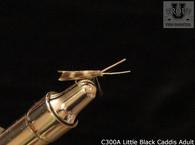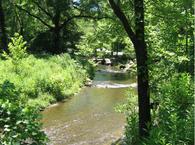Like many avid anglers, James began fishing at a very early age. Thanks to his father and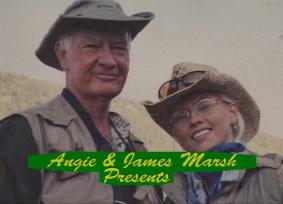 grandfathers, James was able to fish several North Alabama ponds, Guntersville Lake, and the Gulf of Mexico on a regular basis. His fly-fishing experience began at age twelve catching bass and bluegills at local farm ponds and lakes.
grandfathers, James was able to fish several North Alabama ponds, Guntersville Lake, and the Gulf of Mexico on a regular basis. His fly-fishing experience began at age twelve catching bass and bluegills at local farm ponds and lakes.
In his early twenties, he became interested in fishing for the large spawning bass in Central Florida Lakes and the St. Johns River. For eight years he spend at least a month a year doing such in addition to fishing other lakes and the Gulf of Mexico as often as he could. In 1976, he started fishing the BASS pro circuit, along with a lot of other regional and local bass tournaments and did so until 1980. These tournaments took him from his home in Mobile, Alabama to such places as Arizona, New York, and Florida competing against many of the pros that helped found the professional bass circuit.
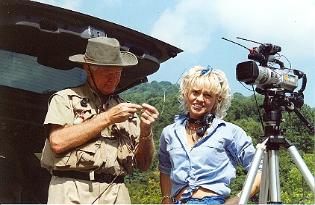 In 1980, James found that he was spending far more time saltwater fishing than bass fishing and stopped competing in the bass tournament circuit to start one of the first ever syndicated TV series on saltwater fishing called the "Gulf Coast Angler". After a successful first year and several added stations, he changed the program name to "Fishing with James Marsh" and expanded the locations to include the Atlantic Ocean and Caribbean. At that time when there were no cable TV stations (only three networks and a few independent stations) his syndicated show was able to obtain very high TV ratings at over twenty-five major markets that represented about half of the nation. For example, in the Tampa, Florida market, running at prime time, 7:00 P.M. Sunday nights, his ratings exceeded that of the three other competing programs with the exception of Sixty Minutes. The ratings of several of his programs in markets airing on weekend schedules exceeded that of NBA (basketball) programs.
In 1980, James found that he was spending far more time saltwater fishing than bass fishing and stopped competing in the bass tournament circuit to start one of the first ever syndicated TV series on saltwater fishing called the "Gulf Coast Angler". After a successful first year and several added stations, he changed the program name to "Fishing with James Marsh" and expanded the locations to include the Atlantic Ocean and Caribbean. At that time when there were no cable TV stations (only three networks and a few independent stations) his syndicated show was able to obtain very high TV ratings at over twenty-five major markets that represented about half of the nation. For example, in the Tampa, Florida market, running at prime time, 7:00 P.M. Sunday nights, his ratings exceeded that of the three other competing programs with the exception of Sixty Minutes. The ratings of several of his programs in markets airing on weekend schedules exceeded that of NBA (basketball) programs.
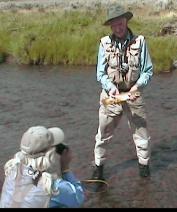 During the 1980s and 1990s, James wrote numerous magazine articles for several publications including Marlin Magazine, Sportfishing Magazine and others. He traveled extensively fishing in several countries. His saltwater fly-fishing experience during those years was primarily limited to sailfish and other offshore species such as dolphin. Most of the other offshore fishing for marlin, tuna, wahoo and such was done with conventional tackle. He has taken three sailfish in one day on the fly off the Mexican coast. Trips to Alaska provided huge rainbow trout, grayling and several different species of salmon on the fly.
During the 1980s and 1990s, James wrote numerous magazine articles for several publications including Marlin Magazine, Sportfishing Magazine and others. He traveled extensively fishing in several countries. His saltwater fly-fishing experience during those years was primarily limited to sailfish and other offshore species such as dolphin. Most of the other offshore fishing for marlin, tuna, wahoo and such was done with conventional tackle. He has taken three sailfish in one day on the fly off the Mexican coast. Trips to Alaska provided huge rainbow trout, grayling and several different species of salmon on the fly.
In 1998, James and his wife Angie, started fly-fishing for trout extensively. He purchased every video, book, magazine and ask every question he could get any angler to answer. Having produced instructional videos on fishing for many years, James was amazed at the low level of both the production quality and content of the videos that were available at that time. Most of them were "watch someone catch a fish" or TV formated programs. The only real attempts at instructional videos that existed were on casting and fly tying. The casting videos poorly attempted to show viewers how to make long cast of up to one-hundred feet or cast that completely straightened the line. None focused on how to make accurate cast of distances appropriate for trout. None demonstrated how to make (messed up cast) curve, pile, and other such cast that are actually necessary to get drag free drifts when fly fishing for trout. The program hosts main objective appeared to be showing the viewers how far they could cast.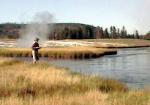
The fly tying videos were like the fly fishing programs, mostly, "watch someone tie a fly" programs. In other words, in James' opinion, most all of the videos available on fly fishing for trout did not include what should be the most important subjects such as the details on what the trout eat, fly presentation, etc. It was also obvious that most of the programs were produced by people that spent more time selling gear in a fly shop, or by guides that spent most of their time attempting to teach beginners the basics. The tying videos were usually hosted by professional fly tiers that regularly tied hundreds of rough imitations necessary to compete with the low priced Keyna market. Most all the fly-fishing videos were, and still are for that matter, hosted by people more interested in selling something else, such as a service or product, than they are teaching the viewer how to catch fish on the fly. Most of the anglers James meet caught trout more as a result of luck than actually knowing what they were doing or anything about what they were trying to imitate.
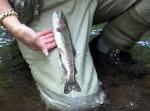 In 1998, James decided to produce his own series of programs that would teach anyone what they needed to know from start to finish. He would have probably named it "The School of Fly Fishing" if similar names had not already been used so often by others. In effect, that is what "Fly Fishing DVD" set out to do - teach anglers, including those that were just beginning or those that had progressed to a level somewhere in between a beginner and an expert, what they needed to know in order for them to be able to catch trout as a result of their actually knowing what they were doing without having to rely on pure luck.
In 1998, James decided to produce his own series of programs that would teach anyone what they needed to know from start to finish. He would have probably named it "The School of Fly Fishing" if similar names had not already been used so often by others. In effect, that is what "Fly Fishing DVD" set out to do - teach anglers, including those that were just beginning or those that had progressed to a level somewhere in between a beginner and an expert, what they needed to know in order for them to be able to catch trout as a result of their actually knowing what they were doing without having to rely on pure luck.
Since 1998, Angie and James have fly-fished in forty-four states (James 49). The couple doesn't spend their time selling fly gear, guiding or in any other related business connected with fly fishing - they spend it fly-fishing. They fly-fish, on camera, year round throughout the nation on a regular basis. One year, they had already spent over two-hundred days fly-fishing for trout during the first ten months of the year. They have caught and made videos of just about every item of trout food that exist including most all the important species of mayflies, stoneflies, and caddisflies. The production of these programs has and still is taking a lot of time, money and considerable effort. Unlike most fly-fishing videos, their videos are not shot in a day or two at one or two locations. Each of them is digitally recorded from coast to coast on dozens of different streams. Hundreds of hours have been spent capturing, studying and shooting closeups of insects and other trout food. Most of these programs are yet to be released. Several that are almost but not fully completed will be released in the near future.
Production of fly-fishing videos is their profession, not a part time effort to promote another related job, product or business. Teaching others to fish has been a lifetime endeavor for James.



